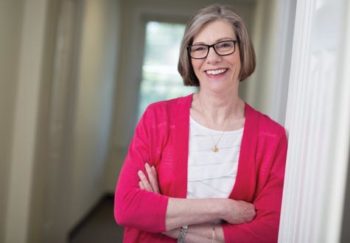Back in 2013, American actress Angelina Jolie opened up about her decision to have an elective double mastectomy, also called a prophylactic bilateral mastectomy. Jolie’s mother and aunt both developed and later died from breast cancer at a young age. Jolie’s family history motivated her to undergo genetic testing. Her testing showed a BRCA1 gene mutation, which increases the risk of breast and ovarian cancer.
According to the National Cancer Institute, about 72% of women with the BRCA1 mutation will develop breast cancer by age 80. Jolie decided to have both of her breasts removed in order to reduce that chance to less than 5%.
Genetic Testing for Breast Cancer Risk
I spoke to Shayna Showalter, MD, a breast surgical oncologist at UVA, to understand more about who undergoes this type of genetic testing, and the thought process around an elective double mastectomy.
Who Gets Tested?
According to Showalter, 90-95% of breast cancer diagnoses are sporadic and not due a genetic mutation. Hereditary breast cancers make up 5-10% of all new breast cancer diagnoses each year. For specific patients that meet a variety of criteria (like those with a personal or family history of breast cancer at a young age), genetic testing can help them make informed decisions before or after a breast cancer diagnosis.
- Pre-Diagnosis: Some, like Jolie, decide to undergo genetic testing before they’ve ever been diagnosed with cancer.
- Post-Diagnosis: “We don’t send every new breast cancer patient for genetic testing, since most new cancers are not by a known genetic mutation. We only send people for genetic counseling and testing if they meet certain criteria,” Showalter explains. That criteria includes the patient’s age, Ashkenazi Jewish heritage, a personal or family history of breast or ovarian cancer at a young age, and/or a family history of breast or ovarian cancer at a young age.
But it’s not as simple as just looking for the BRCA1 and BRCA2 mutations.
“Genetic testing is a very quickly evolving field. It’s a job where you have to really stay on the cutting edge. We’ve known for a long time about the BRCA1 and BRCA2 genes. But there are multiple other genes that increase a woman’s chance of breast cancer. Sometimes doctors even recommend that women who were negative for known mutations 5 years ago to be retested, looking for the more recently discovered mutations,” Showalter says.
Options for Patients with Higher Genetic Risk
“When a patient is found to have one of the mutations that increase risk of breast cancer, we’ll talk to them about their options so they can make educated decisions,” Showalter explains. Those include:
- Risk-reducing surgery
- Increased screening
- Anti-estrogen medication
Risk-Reducing Surgery
According to Showalter, an elective double mastectomy “drops the patient’s chance of developing breast cancer from around 80% down to less than 5%. The surgery’s goal is to prevent developing breast cancer.”
If you elect for a double mastectomy, a breast surgeon does the surgery and works closely with a plastic surgeon for patients that desire breast reconstruction. Reconstruction is a multi-step process, but step one typically occurs at the same time as the mastectomy. For patients with inherited risk of breast cancer, insurance typically covers the double mastectomy and reconstruction.
Do you have a family history of breast cancer at a young age?
The High-Risk Breast & Ovarian Program may be able to help.
Anti-Estrogen Medication
If you wish to avoid surgery but also reduce your breast cancer risk, you can take estrogen-blocking medication. That reduces the risk of developing certain types of breast cancer that are estrogen receptor positive.
Increased screenings
“The idea with increased screening is to detect cancer at the earliest possible stage, but increased screening does not prevent breast cancer. The idea is to catch a new breast cancer as early as possible when it can be treated most easily and successfully,” Showalter explains.
Patients who go this route will generally alternate between receiving an MRI and a mammogram every six months. This way, they’re getting one of each screening every year and not going longer than 6 months between screenings.
The Patient’s Decision
So, is there ever a time where a doctor recommends an elective double mastectomy for their patient? Not according to Showalter. “Not everybody decides to have the surgery. It’s a very personal decision, and it is completely the patient’s choice. We’re just here to educate, and then to do the surgery if it’s what the patient decides.”

